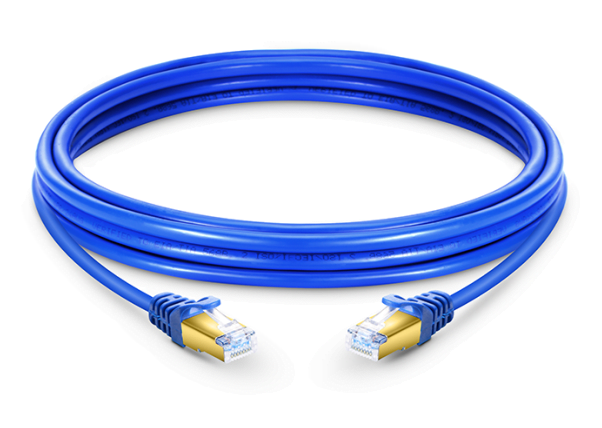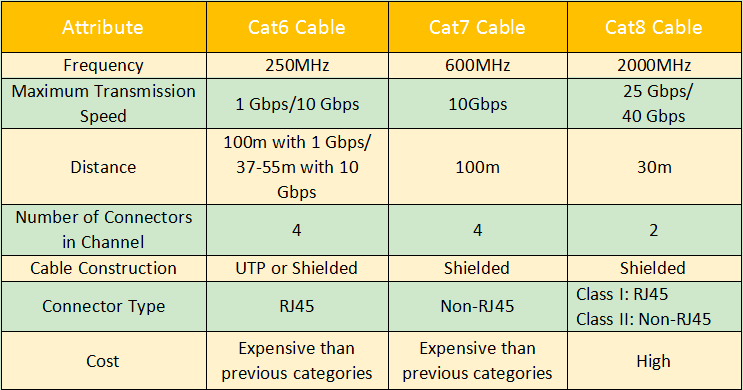As we know, Ethernet cable can be divided into many types such as Cat5, Cat5e, Cat6, Cat7, Cat8, etc. However, not everyone knows the exact difference between them on comparison of Cat6 vs Cat7, Cat7 vs Cat8, etc. Therefore, many people are at a loss on which Ethernet cable they should adopt for their network. Since Cat6, Cat7 and Cat8 cable have aroused much attention among their kind, let’s focus on these three types of Ethernet patch cables, especially on the comparison of Cat6 vs Cat7 and Cat7 vs Cat8 in the following text.
General Introduction on Cat6, Cat7 and Cat8 Cable
Cat6 Cable
Cat6 cable is otherwise called “Category 6” Ethernet cable. It consists of four pairs of copper wire which supports up to 10 Gbps of Ethernet connection. Normally, it supports a maximum transmission speed up to 1 Gbps within 100m. While, Cat6 cable supports 37-55 meters (depending on crosstalk) when transmitting at a speed of 10 Gbps. It can transmit signals up to 250 MHz in frequency, which indicates how often the signal can pass through the cable. What’s more, it uses RJ-45 standard connector and is backward compatible with its previous versions such as Cat5 and Cat5e.

Cat7 Cable
Cat7 cable is otherwise called “Category 7” Ethernet cable. It supports high-speed Ethernet communication up to 10 Gbps. The Cat7 cable is backward compatible with Cat6, Cat5 and Cat5e cable categories. It offers a 100-meter 4-connector channel using shielded cabling, and has been designed to transmit signals at a frequency of 600 MHz.

Cat 7 cables require twisted wires to be fully shielded known as screen shielded twisted pair (SSTP) or screened foiled twisted pair (SFTP) wiring, which completely eliminates alien crosstalk while significantly improving noise resistance. Thus it allows the user to get higher possible speeds even with longer cables.Cat8 Cable
Cat8 cable, or category 8 cable, is an Ethernet cable which differs greatly from the previous cables in that it supports a frequency of up to 2 GHz (2000 MHz), and is limited to a 30-meter 2-connector channel. While, Cat8 cable requires shielded cabling as well. Most importantly, Cat8 Ethernet patch cables can support a speed of 25 Gbps or even 40 Gbps. The physical appearance of Cat8 cable is similar to lower category cables and it can be terminated in RJ45 connections or non-RJ45 connections. Cat8 cable is also backward compatible with its previous versions. Therefore, there is no problem to use it with standard Cat7 connector.

Cat6 vs Cat7 vs Cat8 Cable Comparison
Cat6 vs Cat7
On Cat6 vs Cat7 comparison, transmission frequency and cabling length are two important factors for one to consider. From the introduction above, Cat6 cable offers performance of up to 250 MHz while Cat7 cable is rated for transmission frequency of up to 600 MHz. The maximum cabling length of Cat6 network cable is 100m with 1 Gbps while Cat7 of 100 m with 10 Gbps.
As for cable price of Cat6 vs Cat7, Cat7 cable is more expensive than Cat6 cable if they are compared under the same conditions. If you cannot afford both of them, and then Cat5e would also be a good choice for 10G network.
By the way, the durability differs as well on Cat6 vs. Cat7. Cat6 cable has an estimated life cycle of around 10 years while Cat7 cable of around 15 years.Cat7 vs Cat8
On Cat7 vs Cat8 comparison, transmission frequency and cabling length are also of great importance. Cat7 cable offers performance of up to 600 MHz while Cat8 cable up to 2000 MHz. The maximum cabling length of Cat7 network cable is 100m with 10 Gbps while Cat8 of 30m with 25 Gbps or 40 Gbps.
As for cable price of Cat7 vs Cat8, Cat8 cable is more expensive for its unique feature different from the previous Ethernet cables.
Summary on Cat6 vs Cat7 vs Cat8
Last but not least, you can understand more clearly about the categories of the three Ethernet patch cables through the following table.


